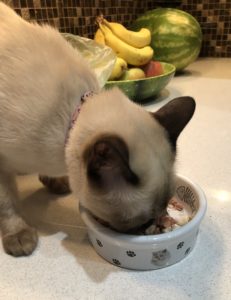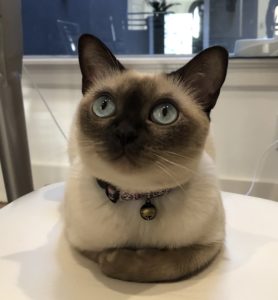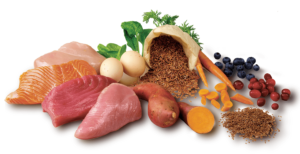Survey Says: Consumers Are Getting Smarter About Pet Food Ingredients
What’s in your pet’s food?
I truly believe that more and more people are finally “waking up” and scrutinizing what’s in their food. Consumer demand is changing what kinds of food grocery stores sell as increased amounts of organic, non-GMO, and natural products are taking up more and more space on shelves and displays. Did you know these trends are now influencing the pet food industry? Pet food ingredients that were taken for granted for decades are now being scrutinized more closely.
Survey Says?
I read an article in a pet industry journal recently that highlighted a list of ingredients that are no longer favorable to pet owners. The Nielsen’s 2017 Category Shoppers Fundamentals Survey revealed that consumers don’t want the following ingredients in their pet’s food:
- GMO 28.8%
- Corn 7.8%
- Hormones 4.8%
- Filler 4.3%
- Artificial preservatives 4.2%
- Artificial colors 3.9%
While those percentages may seem small in general, it indicates to me that consumers are getting smarter. Not only do all the above ingredients have no place in pet food, they contribute to inflammation and the toxic load our pets’ bodies carry. Like humans, what we feed our pets will either make them healthy or sick. Sometimes it can take years for the negative consequences to show up, but eventually they do.
Humans and pets share common diseases and illnesses
Nowadays it’s commonplace for pets to be diagnosed and treated for the same diseases and conditions as humans. These include various types of cancer, diabetes, lymphoma, IBD, obesity, auto-immune diseases and food allergies. Several decades ago this was not the norm. Sadly, many vets aren’t making the diet-disease connection for pets even though there is so much information available about it concerning humans. I find it especially troubling that many of the prescription diets and foods sold in vet clinics often contain the very ingredients that contribute to pets’ diseases and illnesses!
Standards have changed
Prior to factory farming and the rise of the biotech industry experimenting in laboratories with our food supply things were different. Food was grown and distributed locally; livestock was raised humanely in their natural environment; corporations didn’t control the food supply. The words “natural” and “organic” on labels actually meant something.
As the standards and trends for human food spill over to pet food, another Nielsen survey revealed that pet owners are seeking a clean label, superfoods, and functional ingredients. Clean labels demonstrate transparency and what the company values. Pet owners are reading labels and asking questions. Where is this food from? How is it made? Are the animals humanely raised in their natural environments? Pet food manufacturers who show transparency have a greater chance of winning over consumers who share the same values.
Ingredients also need to serve a purpose or function. Therefore, you’ll see products like glucosamine, omega 3s, and probiotics on the labels in order to address a condition or health concern. Consumers know that superfoods are beneficial and demand is growing for these in pet food products.
In addition to clean labels and superfoods, pet parents want products with labels that are easy to read and understand; they want food that is less processed. The old expression “less is more” certainly rings true in this regard! Simple, wholesome, fresh ingredients that haven’t been denatured and destroyed by processing are not only more appealing but healthier.

Human, pet foods will display the same labels
Pet food trends do indeed follow human food trends. You can expect to see the percentages from the survey above rise in the coming years. I predict there will be a growing number of pet food products on the market that will include raw diets, fresh food, humanely-raised animals, and organic ingredients. Furthermore, I wouldn’t be surprised if you see more independent certifications like the Non-GMO Project, Marine Stewardship Council (MSC) and Country of Origin labels. Pet food companies that continue to manufacture food and other products with ingredients that consumers don’t want will continue to lose market share.
Transparency and regulatory enforcement will be key. Pet owners are losing confidence in pet food manufacturers as the number of pet food recalls climb and pets get sick and/or die unnecessarily. FDA, USDA, and state departments of agriculture must enforce the law fairly and consistently. The AAFCO needs to make readily available to consumers, free of charge, definitions of pet food ingredients. Sadly, this doesn’t happen. Profits are often put ahead of our pets’ safety and health. You can learn more about that at Truth About Pet Food.
Talk to your tribe!
Finally, the Nielsen’s 2017 Survey above also tells me we have a ways to go in educating pet owners. The fact that you’re reading this article tells me you care deeply about your cat and her health. Share what you learn with other like-minded friends, colleagues and social circles. Help educate other pet owners who may be in the dark about the reality of pet food. Your voice matters! Voting with your wallet can be the most powerful message to the pet food industry. Without your buy-in they lose profits. What kind of message are you sending them?



